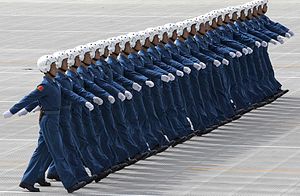China has begun mass producing and delivering its J-15 carrier-based multirole fighter jet, according to Chinese-language reports from state media.
The official People’s Daily reported this week that Shenyang Aircraft Corporation had begun mass producing the J-15. The report, which included a segment from CCTV, also said that Shenyang had begun delivering the aircraft to the People’s Liberation Army.
“The mass production and delivery of J-15 jets not only breaks apart the slander and doubt of some foreign media, it also serves to further boost the progress and level of training for the Liaoning,” The People’s Daily report said, referring to China’s aircraft carrier.
The J-15, which is sometimes called the flying shark, is expected to be China’s primary carrier-based aircraft. It was reversed engineered from Russia’s Su-33, one of which China acquired from Ukraine, but “boasts more advanced, indigenously made avionics, including a shortened tailcone, an arresting hook, and strengthened landing gear,” according to Andrew Erickson and Gabe Collins. The J-15 is also reportedly powered by Chinese-built Taihang (WS-10) turbofan engine.
A prototype of the J-15 first conducted a flight test in August 2009. It began take-off and landing tests from the Liaoning aircraft carrier late last year.
Chinese analysts and state media have often compared the J-15 flying shark to the U.S.-built Boeing F/A-18 Hornet. Back in March, the J-15’s chief designer declared that J-15 is “generally close to the US F/A-18, reaching world class standards.” In state media, Chinese military analysts began picking up this line again early in September, with some analysts suggesting that the J-15 fighter jet was superior in some ways to other fourth generation aircraft like the F-18, French Rafale, and Russian Mig-29K.
By the end of September, however, state media had begun heaping rare criticism on the J-15, calling it nothing more than a “flopping fish.” These reports focused in on the fact that the heavy aircraft could not take off with a full load from Liaoning’s ski-jump ramp. This limitation would, among other things, prevent J-15s from carrying PL-12 medium-range air-to-air missiles, and force the jets to instead rely on the PL-8 short-range missiles.
“Even the Vietnam People’s Air Force can outmatch the PL-8 short-range missile,” these later reports reflected, negatively. “Without space for an electronic countermeasure pod, a huge number of J-15s must be mobilized for even simple missions, a waste for the PLA Navy in using the precious space aboard its sole aircraft carrier in service.”
Amid a flurry of Chinese state media reports this fall on the J-15, The Diplomat noted there were growing signs that the J-15 had entered into mass production. The reports this week seem to confirm these suspicions.
PLAN is currently conducting training exercises with its lone aircraft carrier in the South China Sea. Its unclear if this is related to the initial deliveries of the J-15. However, such training exercises are likely to become more frequent in the months ahead, if the reports on the J-15 are accurate.

































